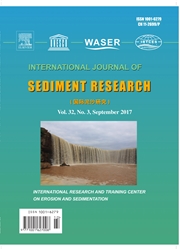

 中文摘要:
中文摘要:
A computational method for steady water waves is presented on the basis of potential theory in the physical plane with spatial variables as independent quantities. The finite Fourier series are applied to approximating the free surface and potential function. A set of nonlinear algebraic equations for the Fourier coefficients are derived from the free surface kinetic and dynamic boundary conditions. These algebraic equations are numerically solved through Newton’s iterative method, and the iterative stability is further improved by a relaxation technology. The integral properties of steady water waves are numerically analyzed, showing that(1) the set-up and the set-down are both non-monotonic quantities with the wave steepness, and(2) the Fourier spectrum of the free surface is broader than that of the potential function. The latter further leads us to explore a modification for the present method by approximating the free surface and potential function through different Fourier series, with the truncation of the former higher than that of the latter. Numerical tests show that this modification is effective, and can notably reduce the errors of the free surface boundary conditions.
 英文摘要:
英文摘要:
A computational method for steady water waves is presented on the basis of potential theory in the physical plane with spatial variables as independent quantities. The finite Fourier series are applied to approximating the free surface and potential function. A set of nonlinear algebraic equations for the Fourier coefficients are derived from the free surface kinetic and dynamic boundary conditions. These algebraic equations are numerically solved through Newton's iterative method, and the iterative stability is further improved by a relaxation technology. The integral properties of steady water waves are numerically analyzed, showing that (1) the set-up and the set-down are both non-monotonic quantities with the wave steepness, and (2) the Fourier spectrum of the free surface is broader than that of the potential function. The latter further leads us to explore a modification for the present method by approximating the free surface and potential function through different Fourier series, with the truncation of the former higher than that of the latter. Numerical tests show that this modification is effective, and can notably reduce the errors of the free surface boundary conditions.
 同期刊论文项目
同期刊论文项目
 同项目期刊论文
同项目期刊论文
 期刊信息
期刊信息
